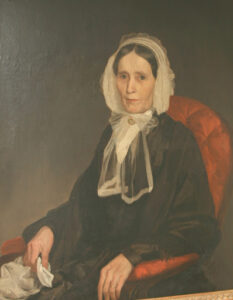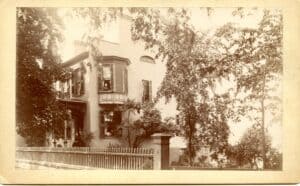The Johnston Women
By Kerry Lippincott, Executive Director
Behind every great man is a great woman. For John Johnston there were seven women – his wife Margaret and their six daughters (Elizabeth, Jessie, Nancy, Margaret, Hope, and Marion). Through newspaper articles, family letters, and Johnston’s own writings their lives can be recreated.
Margaret Alexander (1791-1854) was born and raised in Scotland. On February 8, 1818 she married Johnston and they settled on a farm. Their first child, Elizabeth (1818-1843) was born that same year and their son James (1820-1824) followed two years later. By 1821 Johnston decided to immigrate to the United States. Margaret’s parents, however, were not happy with his decision and did not want them to leave Scotland. A compromise was reached where Johnston would sail for America but would send for his family only after he had prepared a suitable home for them. Margaret and the children would stay with her parents until Johnston sent for them. According to family legend, the Alexanders hoped their son-in-law would either change his mind about settling in the United States or vanish without sending for his family. A letter to Margaret dated October 1, 1822 describes her mother’s feelings – “I received your dismal letter and I think you have paid dear for a husband and he should mind that he is now instead a father and mother, brother and sister to you when you are at such a terrible distance from us.”
In the fall of 1821 Johnston purchased land in Fayette and he named the property Viewfields. After building a house he sent for his family. Margaret and her children (along with Johnston’s sister and two cousins) left Glasgow bound for Montreal in April 1822. Ten weeks after their departure Johnston went to Montreal to meet their ship. The ship carrying his family, however, was so long overdue that it was presumed lost at sea. He went to Quebec for more information. By the time he arrived in Quebec the ship had arrived but continued on to Montreal. Once the family reunited in Montreal, Johnston learned the reason for his family’s delay. It took a month to cross the Atlantic. As the ship neared the mouth of the St. Lawrence River it ran aground on a reef off the Island of Anticosti . The crew and passengers spent six weeks on the island while the boat was repaired. Altogether it took about four months for Margaret and her entourage to journey from Glasgow to Fayette.
 At Viewfields the couple shared in all the responsibilities of managing the farm. Johnston worked in the fields and tended the animals while Margaret managed the household (doing all the cooking and housework, raising geese and chickens, and making butter and cheese to sell). They even ran a tavern out of their home to help make ends meet for part of the 1820s. With their farm on a post coach route that ran daily from Buffalo to New York, they probably only offered meals to their guests. Once the farm was more profitable and their family got larger, the tavern was discontinued.
At Viewfields the couple shared in all the responsibilities of managing the farm. Johnston worked in the fields and tended the animals while Margaret managed the household (doing all the cooking and housework, raising geese and chickens, and making butter and cheese to sell). They even ran a tavern out of their home to help make ends meet for part of the 1820s. With their farm on a post coach route that ran daily from Buffalo to New York, they probably only offered meals to their guests. Once the farm was more profitable and their family got larger, the tavern was discontinued.
Though James died in 1824, five more children joined the family – Jessie (1823-1893), Agnes or Nancy (1825-1905), Margaret (1827-1889), Hope (1830-1899), and Marion (1832-1920). In 1827 Margaret gave the following account to her sister of her fourth daughter’s birth –
. . . I have to inform you that I have got another little Daughter four weeks ago yesterday she is a very good one as yet and is growing like any thing she is very much like what Jessie was but scarsly so fair she has got black hair and very dark blue Eyes – I had not been very stout for better than a Month before and on the Friday I felt myself not well and on Satterday morning sent for the Dr. [sic] who came but as I was not bery bad and he had a good many folks to see he left me about Eliven O.Clock and promised to be back at Sun Down so about that time we began to look for him back again and still expected him every minit until ten when I began to get wors then the Master sent of for him again … but the man was not gon one quarter of an hour until the Child was born and I think I never was better in a similar situation nor had a better recovery. . . I had almost forgot to say that we purpose to call this little thing Margaret . . . I would a wrot you sooner but I was so busy all last Week with the killing of our Swine hoges that I had not time We have salted down 1 Hunderweight of Pork so I think that will serve is to now at until next year.
The Johnston daughters were raised to share in the work of the farm. They were also Margaret’s primary workforce. After Elizabeth’s marriage Johnston wrote “My wife had six daughters and has five now; and she generally has ten geese to every daughter.” The Johnston daughters also received a formal education. All the girls received their early education at a local district school. In addition to the district school, Margaret attended a school in Geneva affiliated with the Presbyterian Church while Nancy, Hope, and Marion attended a private girls’ school in Canandaigua. [i]
Along with an education the Johnston daughters also had the option of whether or not to marry. In December 1840 Elizabeth married John White and settled in Geneva. The couple had two daughters (Margaret and Jessie) but Elizabeth died shortly after giving birth to her youngest child. Since her husband was unable to care for his young daughters, the Johnston family raised the two girls. Jessie married Frederick Swaby in 1843 and settled on a farm in Seneca Falls. They had four children (Annie, Frederick, John and Jessie).[ii]
Perhaps we know the most about the Johnston’s fourth daughter, Margaret. On May 7, 1850 she married Robert Swan (he had what we would call an internship with Johnston to gain hands-on training in farming and lived with the Johnston family for a year between 1848 and 1849). As a wedding present from Robert’s father the couple was given Rose Hill Mansion , 350 acres of land, and money to furnish the house and hire help to run the house and farm. Margaret was 12 years when Rose Hill Mansion was built. Though she didn’t grow up with servants, Margaret could train them and oversee a household. Perhaps Margaret modeled her marriage after her parents, sharing with Robert all the responsibilities and burdens of managing a farm. Eventually the couple had six children (Mary, Lincoln, Maggie, Robbie, Otis, and Agnes). According to her obituary in the Geneva Daily Gazette, Margaret “was a loving mother and wife and was possessed of all those attributes of mind and character which made the truly noble and lovable woman. Enjoying a large circle of acquaintance and friends more knew her but to love and respect her.”
An interesting fact is the three sisters who attended private school did not marry. There are a variety of reasons why Nancy, Hope, and Marion chose not to marry. First, they became their parents’ primary caregivers. Second, perhaps the death of Elizabeth from complications due to childbirth scared them away from marriage. Finally, the sisters formed their own family unit and had fulfilling lives without marriage. After their mother’s death in 1854 (Margaret died suddenly after being struck by lightning), Nancy, Hope, and Marion took over the management of the household, raised Elizabeth’s daughters, and cared for their father. Like their mother, Johnston came to depend on his daughters to help manage Viewfields. While on a buying trip to Canada and with Marion and Nancy on a trip, Johnston wrote to Hope “you must tend to the apples and everything.” By 1877 the farm was rented and the family moved to 533 South Main Street in Geneva. Like their father, the three sisters invested in railroads, land mortgages, and other stocks, and had their own income. Along with church activities, they were involved with the Ontario County Orphan Asylum and Geneva City Hospital. [iii]
Religion played an important role in the Johnston women’s lives. After settling in Geneva, Margaret joined the First Presbyterian Church and her daughters were baptized in the church. As adults the Johnston daughters joined various Presbyterian churches. Elizabeth, Jessie, Nancy, Margaret, and Hope became members of the Associated Reformed Church, also known as the Scotch Reformed Church. Hope, Marion, and Nancy later became charter members of the North Presbyterian Church and members of the church’s sewing school. After their marriage, Margaret and Robert became members of the First Presbyterian Church. They also supported the Sunday School movement and established the Rose Hill Sunday School for working class families living around Rose Hill. Sunday Schools like the one operated by the Swans provided religious guidance and reading lessons. Robert served as the school’s superintendent and Margaret was a teacher.
Perhaps Margaret’s parents were worried that she and her children would lose their ties to Scotland. In an era before phones, letters served as the primary link to Scotland. Though Margaret and John Johnston never returned to Scotland, their daughters made several trips. Jessie went around 1841, Nancy and Marion went in 1860, and Nancy, Hope and Marion made a trip in 1896. Their great-granddaughter Agnes Swan Hutchins also took an interest in her Scottish heritage.
2021 marks the 200th anniversary of Johnston settling in the area. Historic Geneva is commemorating the anniversary with an exhibit on Geneva innovators, blog articles, and social media posts.
Footnotes
[i] Derouise, Anne M. “The Johnstons of Viewfields: Farm and Family in Transition.” Master’s Thesis (State University of New York at Binghamton, 1998),78-9
[ii]Ibid., 92-3.
[iii] Ibid., 95–8.



